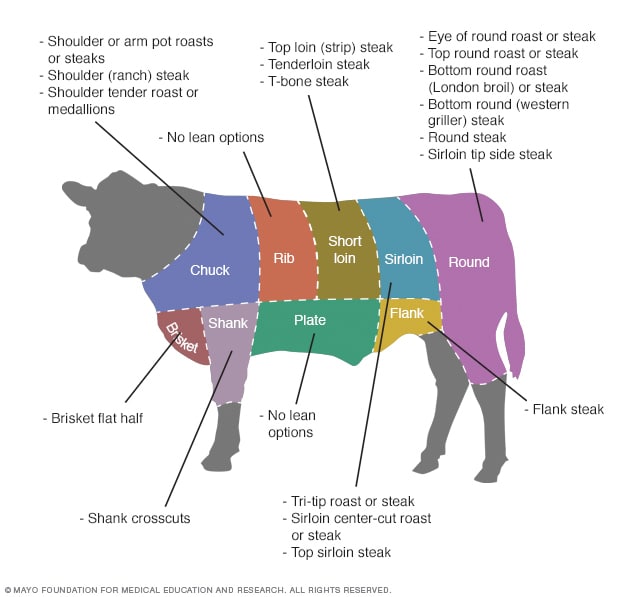
Your guide to the leanest cuts of beef
Cuts of beef: A guide to the leanest selections
Find out which cuts of beef are lowest in fat and cholesterol.
By Mayo Clinic Staff
You might think red meat is off-limits if you’re concerned about your health or trying to watch your weight, but leaner cuts of beef can be part of a healthy diet in moderation.
While the tastiest cuts of beef are often ones with more fat, you won’t necessarily have to sacrifice flavor when choosing lean cuts of beef. Use this guide on cuts of beef to make smart choices.
Nutrition labels for cuts of beef
Wondering which cuts of beef are the leanest? Check the label. The labels on cuts of beef are considered nutrition claims, so they’re subject to government regulations. The U.S. Department of Agriculture (USDA) regulates whether cuts of beef can be labeled as “lean” or “extra lean” based on their fat and cholesterol content.
Lean cuts of beef
The USDA defines a lean cut of beef as a 3.5-ounce serving (about 100 grams) that contains less than:
- 10 grams total fat
- 4.5 grams saturated fat
- 95 milligrams cholesterol
Extra-lean cuts of beef
The USDA defines an extra-lean cut of beef as a 3.5-ounce serving (about 100 grams) that contains less than:
- 5 grams total fat
- 2 grams saturated fat
- 95 milligrams cholesterol
Note that you might see grades of beef (Prime, Choice and Select) on meat packages. Beef grading is a voluntary program that manufacturers can use to judge the perceived quality of their products. Beef grades are not the same as the “lean” and “extra lean” labels.
Selecting cuts of beef
Common lean cuts of beef
Common lean cuts of beef

Many cuts of beef now meet the USDA‘s regulations to qualify as lean or extra lean. Of these, the following are considered extra lean:
- Eye of round roast and steak
- Sirloin tip side steak
- Top round roast and steak
- Bottom round roast and steak
- Top sirloin steak
If you still have questions about which cuts of beef are lean or extra lean, ask your butcher or grocer. If you’re dining out, ask the restaurant server or chef for recommendations for lower fat options.
Keep in mind that the same cuts of beef can have different names. For example, a boneless top loin steak may also be called a strip steak, club sirloin steak or N.Y. strip steak.
Other tips when choosing cuts of beef:
- Choose cuts that are graded “Choice” or “Select” instead of “Prime,” which usually has more fat.
- Choose cuts with the least amount of visible fat (marbling).
- When selecting ground beef, opt for the lowest percentage of fat.
- Limit consumption of organs, such as liver, to about 3 ounces (85 grams) a month.
Preparing cuts of beef
Even the leanest cuts of beef can become diet-busters if you prepare them in unhealthy ways. Here are a few simple methods to control the fat:
- Trim it. Cut off any visible, solid fat from meat before preparing, and then remove any remaining visible fat before eating.
- Drain it. After cooking ground meat, put it into a strainer or colander and drain the fat. Then rinse the meat with hot water. Blot the meat with a paper towel to remove the water.
- Chill it. After cooking, chill beef juices so that you can skim off and discard the hardened fat. Then add the juice to stews, soups and gravy.
Everything in moderation
Even if you choose lean or extra-lean cuts of beef, don’t go overboard. If you want to include beef in your diet, do so in moderation. The Dietary Guidelines for Americans recommends that adults eat no more than a total of 5.5 to 6 ounces (156 to 170 grams) of cooked lean meat, fish, shellfish or skinless poultry a day.
Consider the beef in your diet as a side dish, not a main dish. And remember to enjoy a variety of protein foods, including skinless poultry, beans and fish.
Get the latest health information from Mayo Clinic’s experts.
Sign up for free, and stay up to date on research advancements, health tips and current health topics, like COVID-19, plus expertise on managing health.
To provide you with the most relevant and helpful information, and understand which
information is beneficial, we may combine your email and website usage information with
other information we have about you. If you are a Mayo Clinic patient, this could
include protected health information. If we combine this information with your protected
health information, we will treat all of that information as protected health
information and will only use or disclose that information as set forth in our notice of
privacy practices. You may opt-out of email communications at any time by clicking on
the unsubscribe link in the e-mail.
Thank you for subscribing
Our Housecall e-newsletter will keep you up-to-date on the latest health information.
Sorry something went wrong with your subscription
Please, try again in a couple of minutes
Nov. 24, 2021
See more In-depth
Products and Services
.
Stay connected with us on social media platform for instant update click here to join our Twitter, & Facebook
We are now on Telegram. Click here to join our channel (@TechiUpdate) and stay updated with the latest Technology headlines.
For all the latest Health News Click Here
For the latest news and updates, follow us on Google News.

